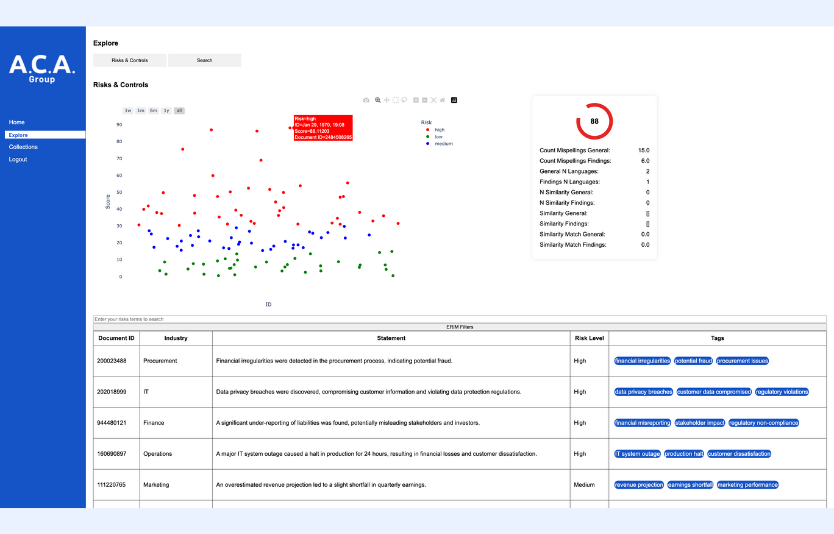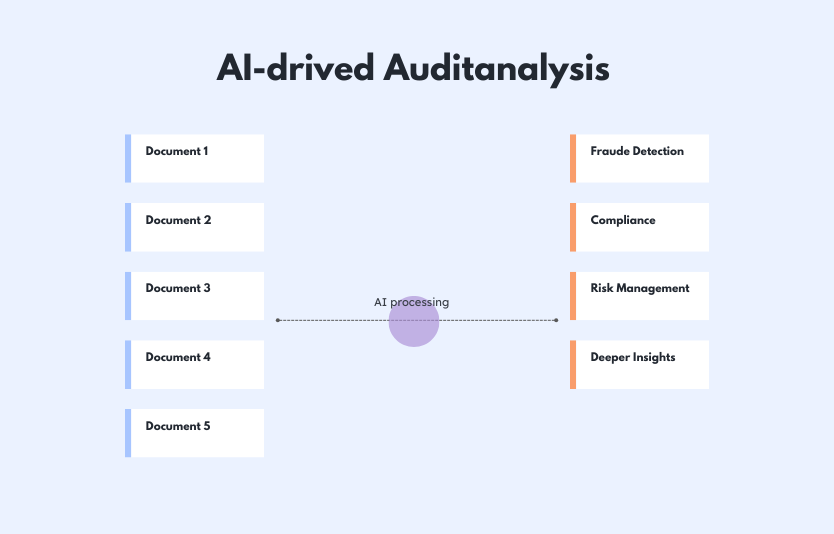

Effective audits are essential for regulatory compliance, risk management, and improving operational efficiency. However, traditional audit processes can be time-consuming and often provide only limited insights. Fortunately, artificial intelligence (AI) offers a revolutionary solution. By applying machine learning (ML), you can optimize audit processes, uncover hidden risks and patterns, and transform how audits are conducted. This article explores how AI can help make your organization's audits more efficient and secure.
Getting more value from your audits with AI
Audit data often holds untapped potential. It contains crucial information about an organization’s operations and risks, but due to its size and complexity, analyzing this data has traditionally been challenging. AI makes it possible to analyze this data at a deeper level, revealing insights that would otherwise remain hidden. As a result, audits can shift from being a necessary task to a strategic opportunity for growth and better decision-making.
The power of AI in audits: key benefits
AI opens up new possibilities for audits by combining advanced data analysis with automation. Here are some ways AI adds value to the audit process:
1. Improved efficiency
By automating repetitive, time-consuming tasks, AI allows auditors to focus on strategic activities. This saves time, boosts productivity, and reduces audit costs.
2. Increased accuracy
AI and ML techniques can analyze vast amounts of data with a precision that's hard for humans to match. This leads to more accurate and reliable audit results.
3. Faster fraud detection
AI can quickly identify anomalies in data through techniques like outlier detection, helping detect fraud or risks early on, so you can address them before they escalate.
4. Compliance and risk management
AI continuously monitors regulatory compliance, contributing to robust risk management and lowering the chances of fines or legal issues.
5. Deeper insights
AI, using techniques like clustering and Natural Language Processing (NLP), provides deeper insights into complex business processes. This helps identify inefficiencies, risks, and areas for improvement, leading to smarter and more effective operations.
AI techniques for better audits
AI technologies are transforming how audits are conducted. Below are some key AI and ML techniques that help make audits more effective:
1. Clustering
Clustering algorithms, like K-means, Hierarchical Clustering, and DBSCAN, group data into clusters based on similarities. For instance, K-means works by grouping data points based on their proximity to a central point (centroid), with the closest points forming a cluster.
In auditing, clustering helps segment financial transactions, customer profiles, or operational data, making it easier to spot patterns indicating risks or inefficiencies. This enables you to detect suspicious groups of transactions that may require further investigation.
2. Outlier detection
Outlier detection identifies data points that significantly deviate from the rest of the dataset. This technique is crucial for spotting fraudulent activities, errors, or unusual transactions.
Outlier detection uses statistical methods, ML models like Isolation Forest, and techniques such as Z-score and IQR (Interquartile Range) to detect these anomalies. By highlighting irregular data points, auditors can focus on the most high-risk elements.
3. Natural Language Processing (NLP)
NLP enables computers to understand, analyze, and generate text data such as emails, contracts, and reports.
NLP models, like BERT and GPT, use techniques like tokenization, stemming, lemmatization, and sentiment analysis to process and analyze text.
This is ideal for identifying relevant information and risks hidden in large amounts of documentation. For example, NLP can scan thousands of emails for suspicious phrases or patterns that indicate potential compliance risks or fraudulent activities.
Real-world example: How AI transforms audits
Let’s look at a practical example. An international financial services provider decided to modernize their audit processes using AI. Traditional audits were time-consuming and often missed risks due to the overwhelming amount of data involved.
By incorporating AI, the organization could quickly identify risks that had previously gone unnoticed.
Discovering risks and trends with clustering
The company used an interactive scatter plot chart, powered by clustering, to visually display risk scores for each audit.
This visualization made it easy to spot high-risk audits, with color gradients ranging from blue (low risk) to red (high risk).

Efficient document navigation with AI tags
Every document was automatically analyzed and tagged based on common features and patterns. These AI-generated tags provided a structured and organized approach to document management, allowing the company to quickly find key information in a sea of data.
Identifying risk factors with NLP
NLP was used to analyze text data from contracts and reports, extracting risk factors. This allowed users to swiftly identify potential risks and gain valuable insights from unstructured data.
AI: Your partner for a more effective audit process

By integrating AI technologies into your audit process, you can not only modernize your audits but also significantly enhance your ability to manage risks and ensure compliance. Whether it’s fraud detection, compliance monitoring, or gaining deeper business insights, AI helps you make faster, more accurate decisions. Auditing is no longer just a requirement - it becomes a powerful tool for growth and success.
Ready to harness the power of AI for your audits?

What others have also read


At ACA, Ship-IT Days are no-nonsense innovation days.
Read more

Whether we unlock our phones with facial recognition, shout voice commands to our smart devices from across the room or get served a list of movies we might like… machine learning has in many cases changed our lives for the better. However, as with many great technologies, it has its dark side as well. A major one being the massive, often unregulated, collection and processing of personal data. Sometimes it seems that for every positive story, there’s a negative one about our privacy being at risk . It’s clear that we are forced to give privacy the attention it deserves. Today I’d like to talk about how we can use machine learning applications without privacy concerns and worrying that private information might become public . Machine learning with edge devices By placing the intelligence on edge devices on premise, we can ensure that certain information does not leave the sensor that captures it. An edge device is a piece of hardware that is used to process data closely to its source. Instead of sending videos or sound to a centralized processor, they are dealt with on the machine itself. In other words, you avoid transferring all this data to an external application or a cloud-based service. Edge devices are often used to reduce latency. Instead of waiting for the data to travel across a network, you get an immediate result. Another reason to employ an edge device is to reduce the cost of bandwidth. Devices that are using a mobile network might not operate well in rural areas. Self-driving cars, for example, take full advantage of both these reasons. Sending each video capture to a central server would be too time-consuming and the total latency would interfere with the quick reactions we expect from an autonomous vehicle. Even though these are important aspects to consider, the focus of this blog post is privacy. With the General Data Protection Regulation (GDPR) put in effect by the European Parliament in 2018, people have become more aware of how their personal information is used . Companies have to ask consent to store and process this information. Even more, violations of this regulation, for instance by not taking adequate security measures to protect personal data, can result in large fines. This is where edge devices excel. They can immediately process an image or a sound clip without the need for external storage or processing. Since they don’t store the raw data, this information becomes volatile. For instance, an edge device could use camera images to count the number of people in a room. If the camera image is processed on the device itself and only the size of the crowd is forwarded, everybody’s privacy remains guaranteed. Prototyping with Edge TPU Coral, a sub-brand of Google, is a platform that offers software and hardware tools to use machine learning. One of the hardware components they offer is the Coral Dev Board . It has been announced as “ Google’s answer to Raspberry Pi ”. The Coral Dev Board runs a Linux distribution based on Debian and has everything on board to prototype machine learning products. Central to the board is a Tensor Processing Unit (TPU) which has been created to run Tensorflow (Lite) operations in a power-efficient way. You can read about Tensorflow and how it helps enable fast machine learning in one of our previous blog posts . If you look closely at a machine learning process, you can identify two stages. The first stage is training a model from examples so that it can learn certain patterns. The second stage is to apply the model’s capabilities to new data. With the dev board above, the idea is that you train your model on cloud infrastructure. It makes sense, since this step usually requires a lot of computing power. Once all the elements of your model have been learned, they can be downloaded to the device using a dedicated compiler. The result is a little machine that can run a powerful artificial intelligence algorithm while disconnected from the cloud. Keeping data local with Federated Learning The process above might make you wonder about which data is used to train the machine learning model. There are a lot of publicly available datasets you can use for this step. In general these datasets are stored on a central server. To avoid this, you can use a technique called Federated Learning. Instead of having the central server train the entire model, several nodes or edge devices are doing this individually. Each node sends updates on the parameters they have learned, either to a central server (Single Party) or to each other in a peer-to-peer setup (Multi Party). All of these changes are then combined to create one global model. The biggest benefit to this setup is that the recorded (sensitive) data never leaves the local node . This has been used for example in Apple’s QuickType keyboard for predicting emojis , from the usage of a large number of users. Earlier this year, Google released TensorFlow Federated to create applications that learn from decentralized data. Takeaway At ACA we highly value privacy, and so do our customers. Keeping your personal data and sensitive information private is (y)our priority. With techniques like federated learning, we can help you unleash your AI potential without compromising on data security. Curious how exactly that would work in your organization? Send us an email through our contact form and we’ll soon be in touch.
Read more

The world of chatbots and Large Language Models (LLMs) has recently undergone a spectacular evolution. With ChatGPT, developed by OpenAI, being one of the most notable examples, the technology has managed to reach over 1.000.000 users in just five days. This rise underlines the growing interest in conversational AI and the unprecedented possibilities that LLMs offer. LLMs and ChatGPT: A Short Introduction Large Language Models (LLMs) and chatbots are concepts that have become indispensable in the world of artificial intelligence these days. They represent the future of human-computer interaction, where LLMs are powerful AI models that understand and generate natural language, while chatbots are programs that can simulate human conversations and perform tasks based on textual input. ChatGPT, one of the notable chatbots, has gained immense popularity in a short period of time. LangChain: the Bridge to LLM Based Applications LangChain is one of the frameworks that enables to leverage the power of LLMs for developing and supporting applications. This open-source library, initiated by Harrison Chase, offers a generic way to address different LLMs and extend them with new data and functionalities. Currently available in Python and TypeScript/JavaScript, LangChain is designed to easily create connections between different LLMs and data environments. LangChain Core Concepts To fully understand LangChain, we need to explore some core concepts: Chains: LangChain is built on the concept of a chain. A chain is simply a generic sequence of modular components. These chains can be put together for specific use cases by selecting the right components. LLMChain: The most common type of chain within LangChain is the LLMChain. This consists of a PromptTemplate, a Model (which can be an LLM or a chat model) and an optional OutputParser. A PromptTemplate is a template used to generate a prompt for the LLM. Here's an example: This template allows the user to fill in a topic, after which the completed prompt is sent as input to the model. LangChain also offers ready-made PromptTemplates, such as Zero Shot, One Shot and Few Shot prompts. Model and OutputParser: A model is the implementation of an LLM model itself. LangChain has several implementations for LLM models, including OpenAI, GPT4All, and HuggingFace. It is also possible to add an OutputParser to process the output of the LLM model. For example, a ListOutputParser is available to convert the output of the LLM model into a list in the current programming language. Data Connectivity in LangChain To give the LLM Chain access to specific data, such as internal data or customer information, LangChain uses several concepts: Document Loaders Document Loaders allow LangChain to retrieve data from various sources, such as CSV files and URLs. Text Splitter This tool splits documents into smaller pieces to make them easier to process by LLM models, taking into account limitations such as token limits. Embeddings LangChain offers several integrations for converting textual data into numerical data, making it easier to compare and process. The popular OpenAI Embeddings is an example of this. VectorStores This is where the embedded textual data is stored. These could, for example, be data vector stores, where the vectors represent the embedded textual data. FAISS (from Meta) and ChromaDB are some more popular examples. Retrievers Retrievers make the connection between the LLM model and the data in VectorStores. They retrieve relevant data and expand the prompt with the necessary context, allowing context-aware questions and assignments. An example of such a context-aware prompt looks like this: Demo Application To illustrate the power of LangChain, we can create a demo application that follows these steps: Retrieve data based on a URL. Split the data into manageable blocks. Store the data in a vector database. Granting an LLM access to the vector database. Create a Streamlit application that gives users access to the LLM. Below we show how to perform these steps in code: 1. Retrieve Data Fortunately, retrieving data from a website with LangChain does not require any manual work. Here's how we do it: 2. Split Data The resulting data field above now contains a collection of pages from the website. These pages contain a lot of information, sometimes too much for the LLM to work with, as many LLMs work with a limited number of tokens. Therefore, we need to split up the documents: 3. Store Data Now that the data has been broken down into smaller contextual fragments, to provide efficient access to this data to the LLM, we store it in a vector database. In this example we use Chroma: 4. Grant Acces Now that the data is saved, we can build a "Chain" in LangChain. A chain is simply a series of LLM executions to achieve the desired outcome. For this example we use the existing RetrievalQA chain that LangChain offers. This chain retrieves relevant contextual fragments from the newly built database, processes them together with the question in an LLM and delivers the desired answer: 5. Create Streamlit Application Now that we've given the LLM access to the data, we need to provide a way for the user to consult the LLM. To do this efficiently, we use Streamlit: Agents and Tools In addition to the standard chains, LangChain also offers the option to create Agents for more advanced applications. Agents have access to various tools that perform specific functionalities. These tools can be anything from a "Google Search" tool to Wolfram Alpha, a tool for solving complex mathematical problems. This allows Agents to provide more advanced reasoning applications, deciding which tool to use to answer a question. Alternatives for LangChain Although LangChain is a powerful framework for building LLM-driven applications, there are other alternatives available. For example, a popular tool is LlamaIndex (formerly known as GPT Index), which focuses on connecting LLMs with external data. LangChain, on the other hand, offers a more complete framework for building applications with LLMs, including tools and plugins. Conclusion LangChain is an exciting framework that opens the doors to a new world of conversational AI and application development with Large Language Models. With the ability to connect LLMs to various data sources and the flexibility to build complex applications, LangChain promises to become an essential tool for developers and businesses looking to take advantage of the power of LLMs. The future of conversational AI is looking bright, and LangChain plays a crucial role in this evolution.
Read moreWant to dive deeper into this topic?
Get in touch with our experts today. They are happy to help!

Want to dive deeper into this topic?
Get in touch with our experts today. They are happy to help!

Want to dive deeper into this topic?
Get in touch with our experts today. They are happy to help!

Want to dive deeper into this topic?
Get in touch with our experts today. They are happy to help!


